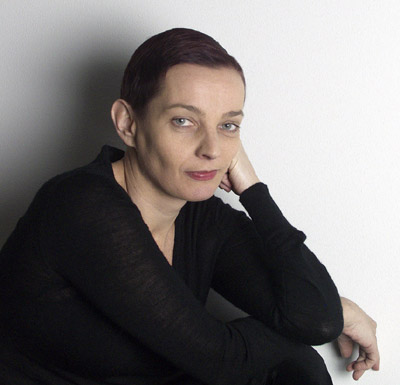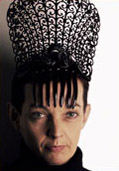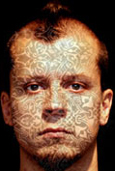 |
[November 12th 2005]

Marita Liulia
10*10
10 questions for 10 Nordic artists
Current artist:
Marita
Liulia
Artificial sets out to dig an alternative route through the activities on the Nordic scene for computer based art. We wanted to find a way to sidestep the restrictions in our own particular outlook so we are therefore launching an unpredictable series of interviews, which will hopefully help us uncover the hidden potentials out there.
Initially we handed Norwegian artist Trine Eidsmo a set of 10 questions and she passed them on to an artist of her choice. After answering the same questions, this artist chooses a new artist ... and so forth. The only criterion for the participants are that they live and work in Scandinavia and create computer based art. In the end, 10 Nordic artists will have answered 10 questions about their art, working process and much more.
The latest artist in the series was Swede Robert Brecevic, who handed the questions over to Finnish Marita Liulia. Here is what she answered.
What is your background?
I studied literature and history of politics but also art, painting and photography. I did my first works for theatre and learned a lot by working with different professionals; writers, set and lighting designers, graphic designers, programmers, musicians, dancers, film makers, producers, etc.
During 80's, I earned my living as a photographer and journalist, traveling all around the world. I became very fond of Asian and Arabic cultures.
All skills learned during those years became very handy when I fell in love with interactive art in 1990 and started to direct large multimedia programs mainly distributed in CD Rom format. During 10 years I directed 5 major works and started my publishing company Medeia in 1997.
  
Marita Liulia
Describe your working process.
I work mostly like a film director and producer in one person. I always start with a literal idea, the form and medias follow. From the beginning I think a lot the target audience of the work, sometimes I might have one type of person in my mind. It helps a lot when I make interface design and content design in general. I do all my works to other people and if I want to communicate with them, I have to understand their language …
After I'm satisfied with the idea, I start the background research work, then I write a detailed manusscript, add photos and maps to it, build up the technical plan, the media plan and check all this with specialists. Then I choose the team, technicians, models, actors, musicians, etc. When all this is done we start to realize the plan by photographing, photo shopping, programming, translating. Too many works to list!
This might take one year and during this year I am living on the edge because of the work consuming all my energy and time, and I have to make sure that I eat and sleep well and do sports in order to survive. Before the work is finished I have a short break where I show it to test audience, analyze everything once more (I call this period 'kill the darlings') and do boldly necessary corrections. Mostly, all the other members of the team are really tired at this moment and my job is to encourage them to do a little bit more. This 'little bit more' is the difference between good quality and excellent quality.
When the program is finished, the next step is packaging, marketing and distribution. This can also be a huge project like in Tarot, where we build up a web store and a whole Tarot product family with many language versions. My works are always realized in several languages (last one, Tarot has been translated to 8 languages!). I also arrange exhibition tours.

Tarot
During the whole period, I spend lots of time and have lots of trouble funding the project. The production of the work consumes enormous amount of time but without it there is no money and without money no art work. It takes about three to four years to realize one work.
I know that in the art school they would not dream of all this. But they would not dream of the possibilities of media art of today either.
Do you solve your technical issues yourself (do you e.g. program yourself) or do you rely on the cooperation with a programmer or a technician?
I have always worked with both technicians and programmers. Depending of the project, my team can be up to 10-15 people.
In which way do you describe your art?
I mainly portray contemporary people from many points of view and use various media platforms to reach different audiences. I'm a writer, a visual artist, but also a researcher and a producer. In my versatile works I combine different art forms, research and technology. For me art is communication and I use communication systems of today in order to make my art available for people in their different environments.
  
From the performance Manipulator. Marita Liulia was in charge of the digital concept, image manipulations and costumes.
How would you describe the relation between computer based art forms and the traditional art forms?
I can only talk about myself. My computer based art is deeply based on traditional arts. I have good classical education in writing, drawing, painting, photography and making research. It's great to be able to do things in reality and in virtual reality. I guess, I will never be unemployed…

From Marita Luilia's online shop
Which role should art institutions and galleries play in regards to work like yours?
I exhibit and perform a lot, actually all the time since 1985. (See my CV at www.maritaliulia.com or just the schedule of this year.) The art institutions with whom I work are mainly museums, theatres and cultural centers. I have my own web store ( www.medeia.com/store ) for distributing the works around the world. I have worked very little with commercial galleries and curators but new ways of working are always welcome.
Which exhibition form do you regard as ideal for your art?
I like to make art for people and therefore my art should be available for them in there where they are! In my case this means: in mobile phones, internet, museums, theatres, book shops and so on.
I work in so many fields. Theatre is ideal for performing arts, museums are ideal for my art exhibitions, the internet is ideal to reach the most of people. I have had over 120,000 visitors in www.maritaliuliatarot.com and 30,000 exhibition visitors for the same work.
Of course it is different to see the original 78 photographs and large scale multimedia in a gorgeous museum setting but I appreciate the chance to offer a glimpse of them on the internet as well.
How would you describe the situation on the Nordic scene for computer based art?
Computer based art is still young art form and in the future we will see it growing a lot towards for example film and TV industry. We are doing well with this in Nordic countries, partly because we have always welcomed technology.
I think especially computer animation is going to be a very important art and entertainment format in coming years but I wonder if the Nordic countries has noticed it yet … The Baltic countries have a great tradition for that and we could cooperate with them.
Several years ago, I founded Prix Möbius Nordica (a cultural media competition) and Nordic professionals are also doing good in the mother competition Prix Möbius International. ( www.prixmobiusnordica.org ). Every year we get one of the main prizes. In general we should do much, much more promotion, marketing and cooperation - also for our local audiences.

Marita Liulia founded the Nordic version of the Prix Möbius.
How do you support yourself financially as a digital artist?
I have supported myself and many other artists and professionals since the early 90's. I also have to thank our state support system for the second 5 years artist grant. With the first one I did works like Ambitious Bitch and Son of a Bitch and with the second Tarot and stage multimedia works like Hunt and Animator.
Information and photos about these works at www.maritaliulia.com
What are you working on now?
In general, I have turned my eyes towards TV because it will be digital soon. I just finished a Tarot TV series manusscript and start to negotiate about funding.
I prepare my studio for photography of my first 'music video' which is actually an computer animation (also for TV) with music of Kimmo Pohjonen ( www.kimmopohjonen.com ).
This year, I am touring a lot in Europe, Asia and North America. Luckily, I love to travel. It inspires me a lot. I'm just back from wonderful Animator (one of Marita's current project, editors comment) tour in Portugal and enjoyed every day. For an interactive artist the interaction with the audience gives the most. I had my birthday on stage and 650 people were singing Happy birthday, Marita in portugese – just spontaneusly. I was in tears.
www.maritaliulia.com
www.maritaliuliatarot.com
www.medeia.com/store
|
 |
|